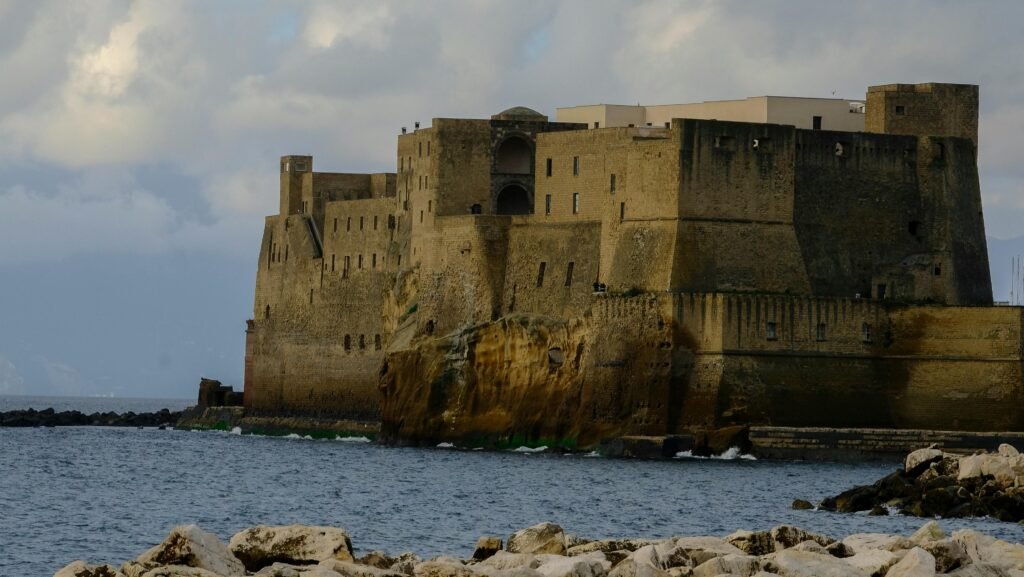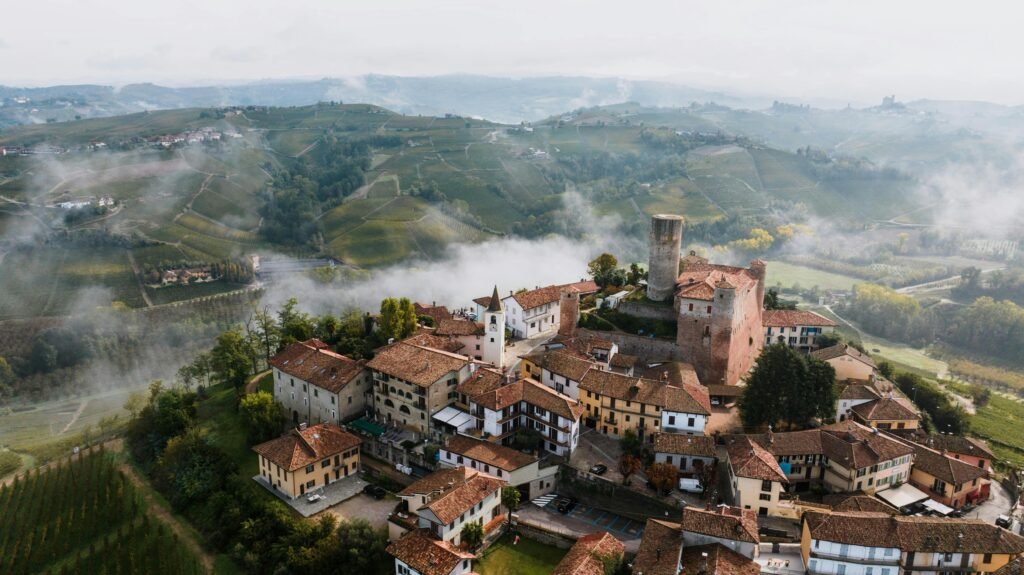Have you ever wondered what it feels like to walk through a castle that’s older than most European cities?
Castel dell’Ovo Naples is a striking coastal fortress where myth, history, and the shimmering waters of the bay converge.
This isn’t just another tourist trap in Naples; it’s a living piece of history that’s been guarding the Bay of Naples for over 2,000 years!
In this guide, I’ll share seven compelling reasons why Castel dell’Ovo should be at the top of your Naples itinerary, plus some insider tips I’ve learned from multiple visits to this incredible castle.
Location: Ovo Castle, Via Eldorado, 3, 80132 Napoli NA, Italy
Holidays : Castel dell’Ovo Naples does not have a specific holiday.
Opening Hours
- Monday to Saturday:
- Summer: 9:00 AM – 7:30 PM (last entry at 7:00 PM)
- Winter: 9:00 AM – 6:30 PM (last entry at 6:00 PM)
- Summer: 9:00 AM – 7:30 PM (last entry at 7:00 PM)
- Sundays and Public Holidays:
- Summer: 9:00 AM – 2:00 PM (last entry at 1:30 PM)
- Winter: 9:00 AM – 2:00 PM (last entry at 1:30 PM)
- Summer: 9:00 AM – 2:00 PM (last entry at 1:30 PM)
The Story Behind Castel dell’Ovo Naples
You know what really hooked me about Castel dell’Ovo? It wasn’t the stunning architecture or even those incredible Bay of Naples views – it was the story behind that weird name.
I mean, “Castle of the Egg”? The Roman poet Virgil, who apparently wasn’t just good with words but also dabbled in some serious magic.
The legend says Virgil placed a magical egg in the foundations of the castle, and as long as that egg remains intact, Naples will be safe and prosperous. Break the egg? Well, let’s just say the city’s in for some serious trouble.
That’s why it is one of the best visiting place in Naples.
What really gets me is how this ancient Roman mythology blended with medieval folklore over the centuries.
During the Middle Ages, people genuinely believed that disasters hitting Naples were connected to cracks appearing in Virgil’s magical egg.
There’s even documented cases of city officials checking on the supposed location of this egg during earthquakes and wars.
The funny thing is, nobody actually knows where this egg is supposed to be hidden – if it even exists at all.
Some say it’s buried deep in the castle’s Roman foundations, others claim it’s sealed within the walls themselves.
Modern Neapolitan storytellers love to embellish the tale, adding their own twists about secret chambers and ancient guardians.
Honestly, whether you believe in magic eggs or not, there’s something pretty cool about standing in a place where ancient legends feel this alive. Every time I walk through those castle grounds, I can’t help but wonder what secrets might actually be hidden in those 2,000-year-old foundations.
Free Admission to One of Italy’s Most Historic Fortresses
Okay, this might sound too good to be true, but hear me out – you can actually explore most of Castel dell’Ovo without spending a single euro.
Yeah, you read that right. In a country where you’ll drop 25 euros just to peek inside the Colosseum, this 2,000-year-old castle opens its doors for free.
Now, let me be clear about what “free” means here.
You can wander through the atmospheric courtyards where centuries of history literally surround you.
The main terraces with those jaw-dropping bay views? Free. Those Instagram-worthy spots with ancient stone walls and Mediterranean backdrops? Also free.
The medieval walkways and most of the castle’s exterior areas? You guessed it – completely free.
The only areas that occasionally require tickets are special exhibitions or certain interior rooms, but honestly, the free areas give you about 90% of the full Castel dell’Ovo experience.
There are some hidden free viewpoints that most tourists completely miss.
Borgo Marinari: The Charming Fishing Village at Your Feet
Borgo Marinari, the tiny fishing village that clusters around the castle’s base, is like stepping into a completely different world.
I discovered this place by accident during my second visit to the castle.
I was heading back to the main road when I noticed these narrow stairs leading down to what looked like a small harbor.
Borgo Marinari feels like authentic Naples in a way that’s getting harder to find in the main tourist areas.
Traditional fishing boats bob in the small marina, their colorful hulls creating perfect reflections in the calm water.
Local fishermen still work from here, and if you’re lucky enough to visit in the early morning or late afternoon, you might catch them bringing in their daily catch.
The restaurants here are something special.
I’m talking about family-run places that have been serving the same seafood recipes for generations.
What really charmed me was how this little village maintains its working character despite being literally attached to one of Naples’ most famous monuments.
You’ll see fishing nets drying in the sun, elderly men playing cards outside their boats, and kids running around the small piazzas just like they probably have for decades.
Perfect Starting Point for Exploring Naples’ Waterfront
What I love about starting from Castel dell’Ovo is how naturally the walk flows.
You begin with ancient history at the castle, transition through the charming fishing village atmosphere of Borgo Marinari, then gradually move into the more elegant and modern sections of Naples’ waterfront.
Santa Lucia harbor is another easy stop along this route.
From here, you can catch boat tours to Capri, Ischia, or just around the bay if you want to see Naples from the water.
I took a sunset cruise once that departed from near the castle, and seeing Castel dell’Ovo illuminated against the darkening sky from the water was absolutely magical.
The public transportation connections are excellent too.
Several bus lines stop near the castle, and you’re within walking distance of multiple metro stations.
This makes it super easy to use Castel dell’Ovo as either a starting point for your Naples adventure or as a perfect end to a day of sightseeing.
Pro tip: Do this walk in the late afternoon so you end up somewhere nice for dinner just as the sun is setting over the bay.
Ancient Architecture That Spans 2,000 Years of History
As someone who’s always been fascinated by how buildings evolve over time, Castel dell’Ovo is like a masterclass in architectural history.
You’re literally looking at 2,000 years of construction techniques, defensive strategies, and artistic styles all layered on top of each other.
You can actually see remnants of the original villa built by Lucullus, a wealthy Roman general, in the 1st century BC.
These aren’t just scattered stones – we’re talking about intact walls, room foundations, and even some mosaic fragments that have survived everything from medieval sieges to World War II bombing.
The Normans arrived in the 11th century and basically built their fortress on top of the Roman ruins.
Then the Angevins came along and added their own modifications.
Each group used different construction techniques and materials, creating this incredible layered effect that you can read like a history book if you know what to look for.
The sea-facing design is particularly clever.
Unlike most medieval castles that were built for land-based attacks, Castel dell’Ovo was designed to defend against threats coming from the Mediterranean.
Recent archaeological work has uncovered even more surprises. In 2019, they found a previously unknown chamber that contained medieval pottery and coins. The preservation efforts are ongoing, and each new discovery adds another piece to the puzzle of how this incredible site evolved over two millennia.
Instagram-Worthy Backdrops for Unforgettable Photos
This place is so photogenic that even my terrible photography skills couldn’t mess it up completely.
The golden hour lighting here is absolutely unreal.
I’m talking about that magical time about an hour before sunset when everything looks like it’s been touched by fairy dust.
The ancient stone walls practically glow, the Mediterranean creates these perfect blue-to-gold gradients, and Mount Vesuvius in the background adds drama that you just can’t fake.
You’ve got dramatic castle walls for that medieval vibe, sweeping ocean views for landscape shots, charming fishing boats for authentic local color, and those incredible panoramic bay views that scream “I’m in Italy!”
The most popular Instagram spot is definitely the main terrace facing Vesuvius.
I’ve seen people wait in line here during peak tourist season just to get their shot.
But honestly, some of my favorite photos came from the less obvious angles – like shooting through the ancient arches to frame the bay beyond, or capturing the contrast between the weathered stone walls and the vibrant blue water.
My biggest tip? Don’t just stick to the obvious viewpoints.
Some of the most unique shots I’ve seen came from photographers who took the time to really explore all the nooks and crannies of this amazing castle.
Easy Accessibility and Great for Families
Let me tell you, one of the biggest surprises about Castel dell’Ovo was how easy it was to get to.
I was expecting some complicated bus route or a long uphill hike, especially since it’s perched right on the edge of the sea. But nope – it was super accessible, even with kids in tow.
We stayed near Piazza del Plebiscito, and from there, it was just a short, flat walk along the waterfront.
If you’re not staying super close, there are buses that drop you just a couple of minutes away.
I checked Google Maps beforehand, and it showed multiple routes with stops within walking distance. And if you’re biking, there are designated bike lanes along the main road, making it easy to ride safely with the family.
Once we arrived, I was relieved to find that the castle grounds were stroller-friendly. There weren’t any stairs or rough terrain to navigate, just paved paths and open spaces. My little one loved running around the courtyard while I snapped photos of the castle from different angles.
The staff was super friendly too – they didn’t bat an eye when we rolled in with snacks, toys, and all the baby gear.
So, whether you’re bringing little ones or just looking for a relaxed way to explore Naples, Castel dell’Ovo checks all the boxes. You can combine it with a visit to the nearby Fish Market or Piazza Municipio, making for a full day of fun without the stress.
Highly recommend adding it to your itinerary!



